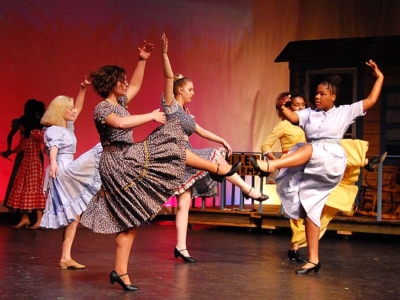Viability of CBE challenged in meeting
- Published: January 23, 2014
Click here to read about the Jan. 13 Council meeting on CBE funding.
The current landscape of commercial real estate building and lending was the focal point at an informational forum on public funding for the Center for Business and Education, or CBE, infrastructure, last Thursday night. And several professionals in the field urged Council not to put money into the project, which they saw as not viable.
“In the late ’80s, this would have been an awesome development,” said Heather Horton, a villager who worked in commercial real estate financing from 1995 to 2008. “But brick and mortar developments are fading out. [With the CBE] we’re operating in an old business model that is not going to work.”
Horton also questioned the proposed CBE fiscal impact report, prepared by Jerry Sutton of Community Resources. The report estimates that the CBE could ultimately attract nine businesses with about 25 professional positions each, an estimate that, according to Horton, is wildly unrealistic.
“I work with businesses every day, and these companies don’t exist,” said Allison Moody of Dayton Commercial Realty. “Any city would be excited to get one of those companies. To expect nine to move to Yellow Springs is laughable.”
About 50 villagers attended the event at the Senior Center. Many said they came to learn or ask questions, and most appeared in agreement with the panel members, who questioned the proposed public funding from several perspectives. Overall, speakers urged Council to not commit $1 million to the project because it is out of step with current commercial real estate reality, and therefore will prove a poor investment for the Village. Council members Karen Wintrow and Brian Housh were also in the audience.
Panel members were Horton; Moody; Dawn Johnson, GIS coordinator of Warren County; economist Taki Manolakos; Kate Hamilton; Matt Carson of Antioch University Midwest and Chrissy Cruz. Christine Roberts acted as moderator.
Manolakos, an adjunct instructor of economics at Wright State, emphasized that he is not opposed to the CBE as such, but to the public funding of it. Council on Monday night approved the first reading of a $1 million bond issuance for the project.
Those who envisioned the CBE had good intentions, Manolakos emphasized, but that is not the point.
“Good intentions don’t make this a good idea,” he said, citing his perception of many empty business parks in the area. Rather than putting a million into the CBE, he urged Council to use the money to upgrade current Village infrastructure.
“What else could be done with this money?” he said.
Cruz, who has been collecting signatures of those opposed to public funding of the CBE, stated that she and others plan to move ahead with a referendum on the issue. The group believes it will have no trouble finding the required number of signatures for a referendum, which requires 10 percent of Yellow Springs registered voters.
“If it’s going to be our money spent, we should be able to vote on it,” Cruz said.
Moody, a commercial real estate professional, questioned the Village taking on more debt when it already owes a considerable amount on bonds for the Bryan Center, and will in the near future need funding to either build or update its water plant.
“The water facility is a need that we have, the CBE is a want,” she said.
Johnson, the Warren County GIS (geographic information systems) coordinator, had several concerns about the CBE process, including what appears a lack of public input. While the public is being asked to pay up to $1 million, decisions regarding the project are made by Community Resources, a private nonprofit that does not hold public meetings.
“We can keep not knowing what’s going on or bring it into the light like a community project,” she said.
Johnson, who works with businesses wanting to locate in Warren County, also sees the CBE site as not desirable to businesses because it’s not on a major highway.
“This particular site doesn’t have attractive business demographics,” she said.
Several audience members expressed agreement with the panelists’ concern over the public funding of the CBE.
“I’m having trouble seeing how this project can come to fruition in the timeline proposed,” said Amy Magnus. “This idea was developed at a different time, and that time has passed.”
To Dan Carrigan, the CBE is a “zombie project.”
“It started out well intentioned but now is only a belief,” he said, stating that he disagrees with CBE supporters who say there is no other alternative to the CBE.
“There is an alternative. Don’t do it,” he said.
Building the CBE infrastructure and having it sit empty for years would negatively impact the community, according to Horton.
As people drive by the empty business park day after day, according to Horton, “it becomes depressing and lowers morale.” Commercial properties also lower the property values of residences in the area, she said.
Horton and Moody also questioned the ability of developers to obtain loans to build buildings in the CBE. According to Horton, while other kinds of commercial lending have bounced back since the recession, “what hasn’t come back is land development. We’re off on the timing.”
Several panelists and audience members speculated on how they would like to see the CBE land used, if not for the CBE. Isaac DeLamatre, the chef at Antioch College, suggested keeping the land in agriculture. Others, especially younger participants, urged Council to use the land to promote sustainability, whether it be in agriculture or other areas.
“I would love to see Yellow Springs as an epicenter of sustainable practices,” Moody said. “I would love for us to be a mecca for that.”
The Yellow Springs News encourages respectful discussion of this article.
You must login to post a comment.
Don't have a login? Register for a free YSNews.com account.

Parkinsons.jpg)













No comments yet for this article.